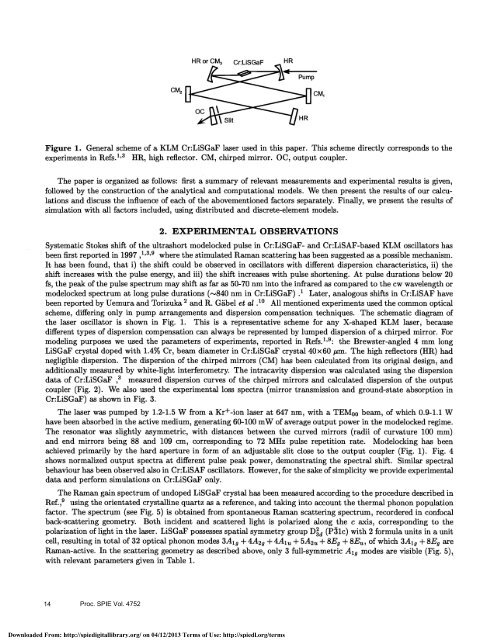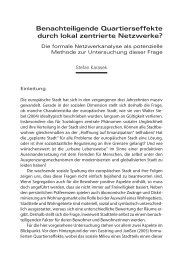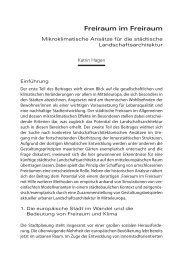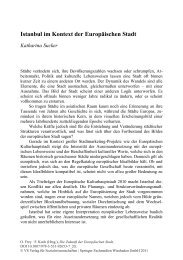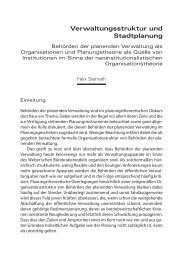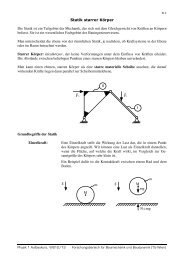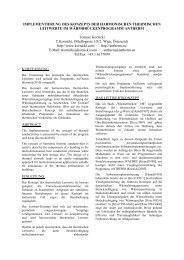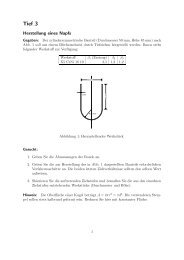Spectral characteristics of ultrashort pulses in Kerr-lens - TU Wien
Spectral characteristics of ultrashort pulses in Kerr-lens - TU Wien
Spectral characteristics of ultrashort pulses in Kerr-lens - TU Wien
You also want an ePaper? Increase the reach of your titles
YUMPU automatically turns print PDFs into web optimized ePapers that Google loves.
HRorCM3 CrLiSGaF HR<br />
CM1<br />
CM2<br />
Figure 1 . General scheme <strong>of</strong> a KLM Cr:LiSGaF laser used <strong>in</strong> this paper. This scheme directly corresponds to the<br />
experiments <strong>in</strong> Refs.1'3 HR, high reflector. CM, chirped mirror. OC, output coupler.<br />
The paper is organized as follows: first a summary <strong>of</strong> relevant measurements and experimental results is given,<br />
followed by the construction <strong>of</strong> the analytical and computational models. We then present the results <strong>of</strong> our calculations<br />
and discuss the <strong>in</strong>fluence <strong>of</strong> each <strong>of</strong> the abovementioned factors separately. F<strong>in</strong>ally, we present the results <strong>of</strong><br />
simulation with all factors <strong>in</strong>cluded, us<strong>in</strong>g distributed and discrete-element models.<br />
2. EXPERIMENTAL OBSERVATIONS<br />
Systematic Stokes shift <strong>of</strong> the <strong>ultrashort</strong> modelocked pulse <strong>in</strong> Cr:LiSGaF- and Cr:LiSAF-based KLM oscillators has<br />
been first reported <strong>in</strong> 1997 ,1,3,9 where the stimulated Raman scatter<strong>in</strong>g has been suggested as a possible mechanism.<br />
It has been found, that i) the shift could be observed <strong>in</strong> oscillators with different dispersion <strong>characteristics</strong>, ii) the<br />
shift <strong>in</strong>creases with the pulse energy, and iii) the shift <strong>in</strong>creases with pulse shorten<strong>in</strong>g. At pulse durations below 20<br />
fs, the peak <strong>of</strong> the pulse spectrum may shift as far as 50-70 nm <strong>in</strong>to the <strong>in</strong>frared as compared to the cw wavelength or<br />
modelocked spectrum at long pulse durations (r.'840 nm <strong>in</strong> Cr:LiSGaF) .' Later, analogous shifts <strong>in</strong> Cr:LiSAF have<br />
been reported by Uemura and ka2 and R. Gäbel et al All mentioned experiments used the common optical<br />
scheme, differ<strong>in</strong>g only <strong>in</strong> pump arrangements and dispersion compensation techniques. The schematic diagram <strong>of</strong><br />
the laser oscillator is shown <strong>in</strong> Fig. 1.<br />
This is a representative scheme for any X-shaped KLM laser, because<br />
different types <strong>of</strong> dispersion compensation can always be represented by lumped dispersion <strong>of</strong> a chirped mirror. For<br />
model<strong>in</strong>g purposes we used the parameters <strong>of</strong> experiments, reported <strong>in</strong> Refs.1'9: the Brewster-angled 4 mm long<br />
LiSGaF crystal doped with 1.4% Cr, beam diameter <strong>in</strong> Cr:LiSGaF crystal 40x60 pm. The high reflectors (HR) had<br />
negligible dispersion. The dispersion <strong>of</strong> the chirped mirrors (CM) has been calculated from its orig<strong>in</strong>al design, and<br />
additionally measured by white-light <strong>in</strong>terferometry. The <strong>in</strong>tracavity dispersion was calculated us<strong>in</strong>g the dispersion<br />
data <strong>of</strong> Cr:LiSGaF , measured dispersion curves <strong>of</strong> the chirped mirrors and calculated dispersion <strong>of</strong> the output<br />
coupler (Fig. 2). We also used the experimental loss spectra (mirror transmission and ground-state absorption <strong>in</strong><br />
Cr:LiSGaF) as shown <strong>in</strong> Fig. 3.<br />
The laser was pumped by 1.2-1.5 W from a Kr-ion laser at 647 nm, with a TEM00 beam, <strong>of</strong> which 0.9-1.1 W<br />
have been absorbed <strong>in</strong> the active medium, generat<strong>in</strong>g 60-100 mW <strong>of</strong> average output power <strong>in</strong> the modelocked regime.<br />
The resonator was slightly asymmetric, with distances between the curved mirrors (radii <strong>of</strong> curvature 100 mm)<br />
and end mirrors be<strong>in</strong>g 88 and 109 cm, correspond<strong>in</strong>g to 72 MHz pulse repetition rate. Modelock<strong>in</strong>g has been<br />
achieved primarily by the hard aperture <strong>in</strong> form <strong>of</strong> an adjustable slit close to the output coupler (Fig. 1). Fig. 4<br />
shows normalized output spectra at different pulse peak power, demonstrat<strong>in</strong>g the spectral shift. Similar spectral<br />
behaviour has been observed also <strong>in</strong> Cr:LiSAF oscillators. However, for the sake <strong>of</strong> simplicity we provide experimental<br />
data and perform simulations on Cr:LiSGaF only.<br />
The Raman ga<strong>in</strong> spectrum <strong>of</strong> undoped LiSGaF crystal has been measured accord<strong>in</strong>g to the procedure described <strong>in</strong><br />
Ref.,9 us<strong>in</strong>g the orientated crystall<strong>in</strong>e quartz as a reference, and tak<strong>in</strong>g <strong>in</strong>to account the thermal phonon population<br />
factor. The spectrum (see Fig. 5) is obta<strong>in</strong>ed from spontaneous Raman scatter<strong>in</strong>g spectrum, recordered <strong>in</strong> confocal<br />
back-scatter<strong>in</strong>g geometry. Both <strong>in</strong>cident and scattered light is polarized along the c axis, correspond<strong>in</strong>g to the<br />
polarization <strong>of</strong> light <strong>in</strong> the laser. LiSGaF possesses spatial symmetry group Dd (P1c) with 2 formula units <strong>in</strong> a unit<br />
cell, result<strong>in</strong>g <strong>in</strong> total <strong>of</strong> 32 optical phonon modes 3A19 + 4A29 + 4A1 + 5A2 + 8E9 + 8Ev, <strong>of</strong> which 3A19 + 8Eg are<br />
Raman-active. In the scatter<strong>in</strong>g geometry as described above, only 3 full-symmetric A19 modes are visible (Fig. 5),<br />
with relevant parameters given <strong>in</strong> Table 1.<br />
14<br />
Proc. SPIE Vol. 4752<br />
Downloaded From: http://spiedigitallibrary.org/ on 04/12/2013 Terms <strong>of</strong> Use: http://spiedl.org/terms


